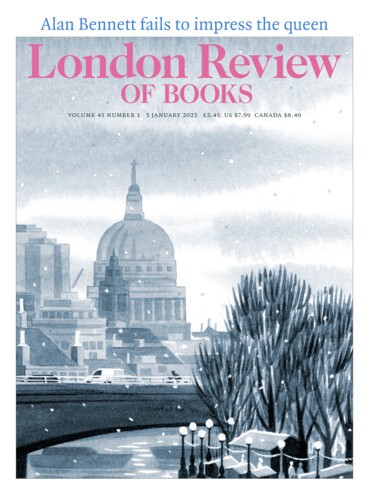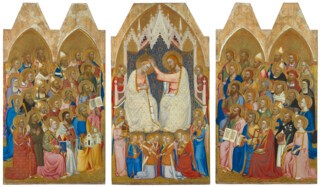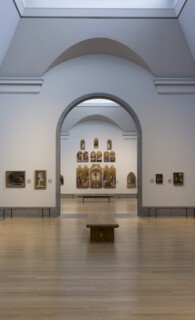When an enormous 14th-century polyptych made for the Florentine church of San Pier Maggiore was bought by the National Gallery in 1857, the director, Charles Eastlake, didn’t really know what to do with it. The altarpiece, painted by Jacopo di Cione and his workshop in the early 1370s, is one of the biggest made in the 14th century and, even though it had been dismantled after the church was destroyed in the 18th century, all twelve of the main panels entered the collection (only the bottom predella register and the pilaster panels were missing). The 1857-58 acquisition report reveals that Eastlake had wanted these gold-ground panels as ‘specimens’ of the origins from which ‘Italian art slowly advanced’; less as artworks in their own right, and more as foils to the work made later in the Renaissance. Gallery space was already tight, however, and this twelve-part ‘specimen’ was going to take up a lot of it. The panels therefore remained separate, some going into storage while others were slotted into the chronology on the gallery’s walls. At the end of the century, the three-panel bottom tier – showing Christ crowning the Virgin, flanked by crowds of adoring saints – ended up on the landing outside the galleries proper, squeezed between doors and columns. Visitors might have caught a glimpse of it on their way into the great hall.
Although the value of 14th-century Italian painting had long since come to be appreciated by art historians and curators, it wasn’t until 1991 that the San Pier Maggiore altarpiece found a suitable home, when the National Gallery’s Sainsbury Wing opened. The space, designed by Robert Venturi and Denise Scott Brown, isn’t quite the ecclesiastical setting for which the artwork was made, but it comes surprisingly close: high ceilings with simplified apses, top-lighting and pale grey walls with dados made of grey pietra serena. Almost imperceptibly, the archways between galleries get progressively narrower, and their columns progressively smaller. This clever use of false perspective increases the apparent distance to the far wall, simulating the sort of grand vista that would have led up to a Renaissance high altarpiece.
However sensitive this new architectural setting, Jacopo’s polyptych still posed a problem to the National Gallery’s curators: it was in pieces. In their original setting, the panels would have been displayed in a complex, four-tiered framework, comprising a variety of pointed arches, gabled buttresses and pinnacles with finials. The fashion for these tall altarpieces, whose Gothic silhouettes resembled those of contemporary church façades, came in part from a 13th-century Church decree (though unlike candles and a crucifix, an altarpiece was not a liturgical requirement). The Fourth Lateran Council of 1215 had accepted the doctrine of transubstantiation and had also agreed that the priest officiating mass could face away from the congregation. The space behind the altar was used to engage the congregation and as a backdrop to the climactic elevation of the host; low dossals grew into ever taller polyptychs.
Jacopo’s polyptych was also the backdrop to a specifically Florentine ceremony. The church of San Pier Maggiore was founded in the fifth century by Saint Zenobius, the first bishop of Florence and subsequently one of its patron saints. From the 11th century, it was owned by a Benedictine convent. After the church was rebuilt and the altarpiece was installed at the end of the 14th century, it became the site of a ritual relating to the election of the bishop of Florence. Having been ordained in the Cathedral of Santa Maria del Fiore, the new bishop would process to San Pier Maggiore, where, standing in front of the high altarpiece, he would ‘marry’ the city by giving a ring to the abbess of the convent. The towering polyptych was the stage set for this strange piece of theatre.
The separate ‘tychs’ that arrived at the National Gallery from San Pier Maggiore in 1857 were shorn of their original structure. In the 14th century, a polyptych frame usually cost more than the paintings it enclosed, but today very few original frames survive and the vast majority of trecento artworks in museums are fragments. Some polyptychs didn’t make it out of the Renaissance unscathed, cut up instead to satisfy the taste for single-field altarpieces (called pale) as early as the 15th century. Those that survived were probably dismembered in the late 18th or 19th centuries, when demand from new national picture galleries across Europe – and, perhaps more important, from individual collectors – led dealers (and sometimes churches) to split up multi-panel altarpieces to produce individual ‘artworks’. The construction of a polyptych – nailing and glueing moulding strips around the edges of a piece of wood, then covering it in a single piece of linen to be gessoed and gilded, all before the painting happened – meant that the panels and the frame couldn’t be separated without causing irreparable damage. Polyptychs had to be sawn apart and frames were sacrificed in favour of the panels at their centre.
The panels of the San Pier Maggiore altarpiece had been slotted into ‘Gothic’ framing structures during the 19th century, becoming, in the modern sense, pictures in frames. The replica frame, apparently copied from an altarpiece in Santa Maria Novella made by one of Jacopo’s brothers, wasn’t bad at all, though a framing specialist could spot it a mile off – and even tell you which decade of the 19th century it came from. The sheer size of the altarpiece remained the bigger problem for the curators: even with the advent of the Sainsbury Wing, it was too large and cumbersome to fit onto a single wall in its original, three-tier configuration. For almost thirty years, the panels were arranged across two walls, the Coronation of the Virgin and attendant saints facing the other two tiers across the room. Displayed this way, the work lost not only a sense of its intended function but also much of its symbolism. The Resurrection and Ascension panels, whose elevating message was once emphasised by their literal height, were now below eye level, with the Holy Trinity, intended as the apex of it all, sitting limply above them, neither low enough to look at closely nor high enough to appreciate iconographically.
Then, in 2018, the National Gallery did something that Charles Eastlake wouldn’t have dreamed of, giving Jacopo’s polyptych a prominence previously accorded to an altarpiece by Raphael, on the largest wall of the Sainsbury Wing. The curators wanted to act on the opportunity, unique outside Italy, to show nearly all of a trecento altarpiece in one place. The back wall of the central enfilade of galleries, with its high apse arching up into the cornice, was the only space tall enough to accommodate it. When they were warned that the sheer mass of the altarpiece frame couldn’t safely be supported by the gallery wall, the curators were forced to take a radical decision. They removed the panels from their frames and hung them, naked-edged, on the wall.
The altarpiece had lost a frame – but now the panels framed and oriented one another. The bare-wood edges serve as a reminder that what we are looking at is a fragment, if a very big one. The 19th-century Gothicising frame was perhaps closer to the original structure, but it gave a deceptive impression of wholeness. The decision to unframe wasn’t some postmodern museological experiment, but an example of practical constraints resulting in a surprisingly effective compromise.
The Sainsbury Wing is closed at the moment for remodelling, part of the gallery’s 200th birthday celebrations. The new architects plan to open up the entrance hall, removing part of the low ceiling and thinning out the squat pillars to make the space more inviting. The crypt-like atmosphere Venturi and Scott Brown had wanted to evoke will be lost, but there are no plans to alter the gallery space, including the high wall at the end of the enfilade, where I hope Jacopo’s panels will be prominently displayed once again.
Send Letters To:
The Editor
London Review of Books,
28 Little Russell Street
London, WC1A 2HN
letters@lrb.co.uk
Please include name, address, and a telephone number.



